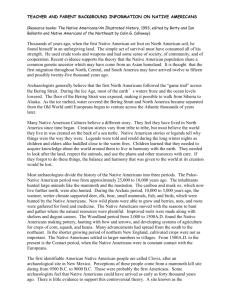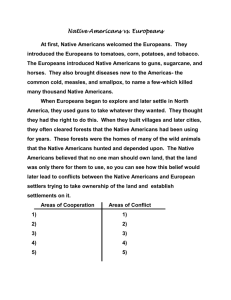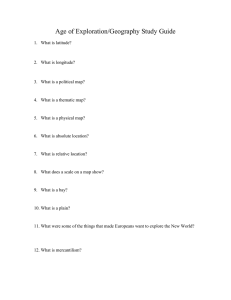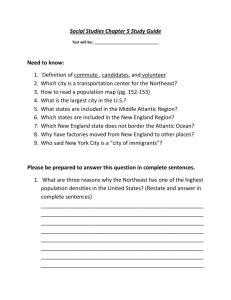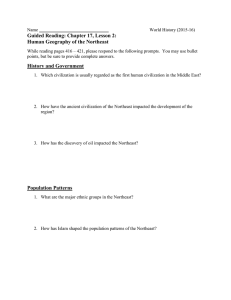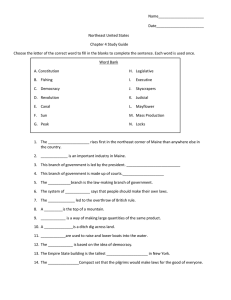TEACHER AND PARENT BACKGROUND INFORMATION ON NATIVE AMERICANS VOCABULARY
advertisement
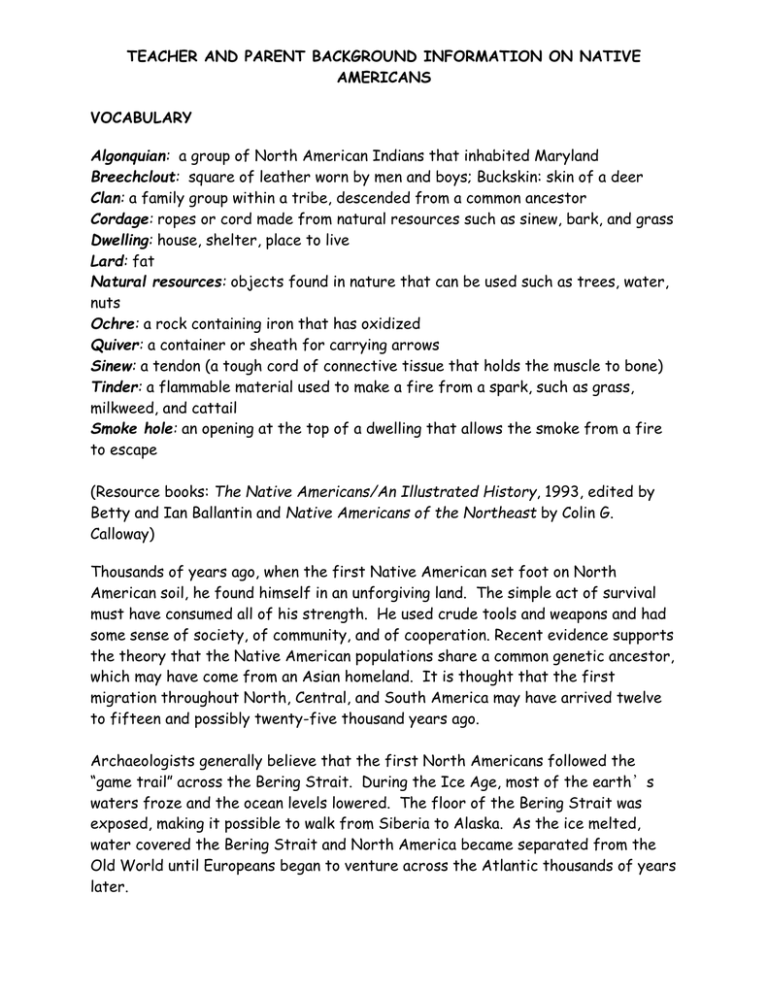
TEACHER AND PARENT BACKGROUND INFORMATION ON NATIVE AMERICANS VOCABULARY Algonquian: a group of North American Indians that inhabited Maryland Breechclout: square of leather worn by men and boys; Buckskin: skin of a deer Clan: a family group within a tribe, descended from a common ancestor Cordage: ropes or cord made from natural resources such as sinew, bark, and grass Dwelling: house, shelter, place to live Lard: fat Natural resources: objects found in nature that can be used such as trees, water, nuts Ochre: a rock containing iron that has oxidized Quiver: a container or sheath for carrying arrows Sinew: a tendon (a tough cord of connective tissue that holds the muscle to bone) Tinder: a flammable material used to make a fire from a spark, such as grass, milkweed, and cattail Smoke hole: an opening at the top of a dwelling that allows the smoke from a fire to escape (Resource books: The Native Americans/An Illustrated History, 1993, edited by Betty and Ian Ballantin and Native Americans of the Northeast by Colin G. Calloway) Thousands of years ago, when the first Native American set foot on North American soil, he found himself in an unforgiving land. The simple act of survival must have consumed all of his strength. He used crude tools and weapons and had some sense of society, of community, and of cooperation. Recent evidence supports the theory that the Native American populations share a common genetic ancestor, which may have come from an Asian homeland. It is thought that the first migration throughout North, Central, and South America may have arrived twelve to fifteen and possibly twenty-five thousand years ago. Archaeologists generally believe that the first North Americans followed the “game trail” across the Bering Strait. During the Ice Age, most of the earth’s waters froze and the ocean levels lowered. The floor of the Bering Strait was exposed, making it possible to walk from Siberia to Alaska. As the ice melted, water covered the Bering Strait and North America became separated from the Old World until Europeans began to venture across the Atlantic thousands of years later. Many Native American Cultures believe a different story. They feel they have lived in North America since time began. Creation stories vary from tribe to tribe, but most believe the world they lived in was created on the back of a sea turtle. Native American stories or legends tell why things were the way they were. Legends were told and retold during the long winter nights as children and elders alike huddled close to the warm fires. Children learned that they needed to acquire knowledge about the world around them to live in harmony with the earth. They needed to look after the land, respect the animals, and use the plants and other resources with care. If they forgot to do these things, the balance and harmony that was given to the world at its creation would be lost. Most archaeologists divide the history of the Native Americans into three periods. The Paleo-Native American period was from approximately 25,000 to 10,000 years ago. The inhabitants hunted large animals like the mammoth and the mastodon. The caribou and musk ox, which now live further north, were also hunted. During the Archaic period, 10,000 to 3,000 years ago, the warmer, wetter climate supported deer, elk, bear, small mammals, fish, and birds, which were hunted by the Native Americans. New wild plants were able to grow and berries, nuts, and roots were gathered for food and medicine. The Native Americans moved with the seasons to hunt and gather where the natural resources were plentiful. Improved tools were made along with shelters and dugout canoes. The Woodland period from 3,000 to 1500A.D. found the Native Americans making pottery, hunting with bow and arrows, and developing systems of agriculture for crops of corn, squash, and beans. Much advancement had spread from the south to the northeast. In the shorter growing period of northern New England, cultivated crops were not as important. The Native Americans settled in larger numbers in villages. From 1500A.D. to the present is the Contact period, when the Native Americans were in constant contact with the Europeans. The first identifiable Native American people are called Clovis, after an archaeological site in New Mexico. Perceptions of these people come from a mammoth kill site dating from 9500 B.C. to 9000 B.C. These were probably the first Americans. Some archaeologists feel that Native Americans could have arrived as early as forty thousand years ago. There is little evidence to support this controversial theory. A site known as the Meadowcroft Shelter in southwestern Pennsylvania provided evidence of a fire pit, two human bone fragments, and some stone tools. The oldest radiocarbon date is just under nineteen thousand years ago. This however, is controversial and at this time, the only acceptable proof of the earliest occupation of the western Hemisphere comes from the Clovis presence. The Native American used multiple survival strategies such as hunting, fishing, harvesting wild plants, and farming. This led to a great diversity in the Americas, which was dependent upon the regional extremes of temperature and climate. As with the Clovis society, most developing cultures had respect for the animals that helped sustain them. The carcass may have been butchered in a special way, using all parts of the animal. In the southwest, men continued to hunt but the economic burden shifted to the women. Their foraging and gathering made them principal providers. It became a matriarchal society with prosperous women sometimes taking more than one husband. Unlike their Clovis ancestors, the California Native Americans adapted to their environment relying on more than a few species of plants and animals. They lived off fish, shellfish, seals, whales, deer, bear, elk, rabbit, and a variety of seeds. They hunted and foraged but did not farm. These nonagricultural people had the highest aboriginal population density in North America. Middle American civilizations became more dependent on agriculture. This includes the Mayan (300-900A.D.) and Aztec (1325-1520A.D.) civilizations. The sedentary lifestyle (remaining in one area) created multisocietal systems with marriages occurring with social equals only. Great cities were built and land was looked at differently than it was by the hunter/gatherer societies. Most commoners were farmers living outside the city limits but craft specialists, traders, and warriors could be found in the city. The southwest developed a diversified lifestyle combining farming with hunting and gathering. The Eastern Woodlands hosted Native American people speaking at least 68 distinct languages. This area was inhabited by people for at least 10,000 years. They learned to protect themselves against fluctuations in natural resources by economic exchanges with others; by moving their home range with the seasons to take advantage of availability of grasses, fruits, nuts, fish, and game; by staying close to the major river valleys; and by storing food for future use. Bison-hunting and maize-growing Native Americans prospered in the Great North American Plains with its cold winters and hot summers. Like all societies, the Native Americans of the plains had conflicts. Most could be resolved through mitigation. If this failed, the common form of Plains warfare usually involved ambushes and ritualized battles causing few deaths. Horses evolved on American soil forty million years ago but became extinct in their homeland. The horse was not reintroduced until 1493 by Christopher Columbus. During pre-Columbian times, the Native American hunted the buffalo on foot. The Plains Native Americans developed ways to kill large numbers of bison and minimize danger to the hunters. One way was to send the bison over the edge of a precipice. Northeast Native Americans In post-Columbian times, the Northeast was occupied by Algonquian communities along the coastal watersheds and Iroquois living along the interior waterways. These were two of the largest language families in the area. Tribes that were included under the Algonquian family might not have spoken the same exact language, but shared similarities. Both groups were matrilineal with the women performing the life-giving duties of farming. Storable food raised by the farming communities were traded for furs, meat, nuts, and exotic goods such as flints, mica, and shells bartered for along the coast-to-coast trade routes. Dwellings consisted of longhouses and wigwams. The longhouses were occupied by many families of the same matrilineage and were 50 to 200 feet long and 25 feet wide. Sometimes a palisade, or tall fence was built around the village for defense. Northeastern Native American tribes usually consisted of several villages, bands, and clans loosely united by language, kinship, and shared interests. Villages usually numbered in the hundreds but could be as large as several thousand. Numbers would vary with the seasons. The family was very important to the Northeast Native American life and included the extended family of grandparents, aunts, uncles, cousins, and in-laws. Children were a part of the family activities from birth and learned to respect their elders, especially grandmothers. Clans were groups of related people who could trace their descent to a common ancestor. Each clan had an animal symbol. For example, the Delaware had Wolf, Turkey, and Turtle clans. Some cultures were matriarchal and would trace their ancestry on their mother’s side of the family. A boy whose mother was from the Bear clan would not be allowed to marry someone from his clan. If he married into the Turtle clan, his children would be members of the turtle clan and would be raised by that clan. Numerous social structures helped to keep order with the diversified peoples occupying the Northeast. Many governed themselves through a variety of relationships and obligations that served the interests of all. Leaders were usually men and possibly women who did not rule, but offered advice and tried to resolve disputes. Decisions were not made by the majority, but by consensus of all involved. Everyone needed to agree. Among the Iroquois, the clan mothers chose the council chiefs and could remove them from office. People were expected to behave in an acceptable manner. The family and community were a major importance to a person’s life and acting disruptively might mean the loss of the clan’s support. Some confederacies between tribes were formed. The most well known in the Northeast was the Iroquois Confederacy or the League of the Five Nations. Membership insured peace with other members. The five tribes were the Mohawk, Oneida, Onondaga, Cayuga, and Seneca. Later, after being driven from their home in the Carolina’s, the Tuscaloosa joined, making it the League of the Six Nations. Seasons dictated the activities in the Northeast. Early spring meant tapping trees and boiling sap for maple sugar. Late spring involved planting corn, beans, and squash known to some as the “Three Sisters”, as well as pumpkins, sunflowers, and tobacco. Fishing was done near waterfalls and rapids for shad, salmon, and other fish swimming upstream to spawn. Summer meant maintaining crops and gathering berries by the women and children while the men hunted. Summer was also a time of visiting, trading with, and raiding the neighboring tribes. Fall was a time of harvesting and drying the crops, butchering and smoking meat, and tanning leather hides. Those that lived near shallow lakes, ponds and swamps would canoe to areas of wild rice to harvest it. Winter brought the extended families together in the village for feasts, ceremonies, and story telling. The Native Americans of the Northeast sported a variety of hairstyles. Some plucked out all their hair except for a scalp lock, others wore their hair long, often in braids, or in roach style (brushed straight back from the forehead). Both men and women in many tribes tattooed their bodies and faces. With the introduction of the Europeans to the Northeast area, life, as the Native Americans knew it, changed drastically. Native Americans were puzzled by the first Europeans they met. They found their behavior to be rude and aggressive. The Native Americans were used to sharing and treating strangers with hospitality. Trading was an even exchange between people. Warfare was on a small scale and was more about personal glory than killing. After their initial contact, the Native Americans viewed the Europeans with suspicion and fear. More Native Americans died from the diseases brought to the Northeast by Europeans than by their bullets. Germs from smallpox, bubonic plague, measles, influenza, cholera, typhus, and others were new to North America. Because of their first time exposure to these diseases, some tribes were totally lost, while others may have lost 50 to 90 percent of their numbers. Another devastating new encounter to the Native Americans was the introduction of alcohol. Trading began as a mutually beneficial activity, which eventually severely decreased important animal life and basic skills for survival. The Native Americans were eager to obtain the new things such as metal goods and woolen blankets from the Europeans. In order to survive in the New World, the Europeans were just as eager to learn about the knowledge and skills that the Native Americans possessed. Squanto, a Patuxent Native American who had been kidnapped to Europe and then returned to the Northeast, aided the pilgrims of Plymouth Colony. The Native Americans sharing of knowledge saved many of the first settlers trying to survive the New World. Thanksgiving is celebrated in memory of the time the Wamponoag Native Americans shared a meal with the pilgrims. The Europeans soon adapted many of the Native Americans’ possessions to their needs. They learned to make canoes, snowshoes, moccasins, and toboggans; and to plant corn and other domesticated plants. Learning to tap maple trees for their sweet sap meant the difference between life and death during harsh winters. Summary In summary, we tend to think of Native Americans as a single people, but they were as diverse as the various nationalities of Europe. The natural resources of their area dictated their way of life. The status of women for some cultures was little more than a child bearer and worker whereas in other cultures the women controlled the political power. Women appointed the men to the Iroquois council. If the men did not vote as instructed or follow the women’s wishes, they could be removed from office. Some women, in certain societies, owned the dwelling and all its furnishings, the tools, the crops, the sheep, and the horses. The man’s possessions were restricted to his clothes and weapons. Family responsibility among the sexes varied from tribe to tribe, but usually the man was the hunter and the warrior, taking charge of protecting the family. Not all tribes engaged in war. Some were pacifists. The Native Americans held many different beliefs about the origin of man and earth, about spiritual realms, and about afterlife. The majority believed that all living things had souls and should be shown the proper respect and consideration. Because of this belief, the Native Americans existed in rare harmony with their environment. Unlike the Europeans, they did not believe the land could be owned any more than the sunshine or rain could be owned. The diverse Native American cultures have been evolving over the millennia. It has not necessarily been an upward spiral from primitive to civilized cultures. Their evolution involved adapting, problem solving, and surviving. One culture was not necessarily better than the other. From the book, The Native Americans, “Kote Loath, a Chumash man, grasped the dilemma of human change and evolution:” “There is no “better” or “worse,” only different. That difference has to be respected whether its skin color, way of life, or ideas. The Chumash have a story about this. It begins with a worm that is eaten by a bird. The bird is eaten by a cat whose self-satisfaction is disrupted by a mean-looking dog. After devouring the cat, the dog is killed by a grizzly bear who congratulates himself for being the strongest of all. About that time comes a man who kills the bear and climbs a mountain to proclaim his ultimate superiority. He ran so hard up the mountain that he died at the top. Before long the worm crawled out of his body.” The Algonquian and Iroquoian languages provide us with words and names that are used today. The following are just a few of those words. Moose/raccoon/caribou/skunk/chipmunk/succotash/powwow/moccasin/opossum/wo odchuck/toboggan/Massachusetts/Agawam, Mass./Penobscot, Maine Niagara, N.Y./ Genesee, N .Y. /Allegheny, Pa./Erie, Pa/Susquehanna, Pa./Merrimack, N.H./ Connecticut/Illinois/Miami, Ohio/Michigan/Ottawa, Ohio/Chicago, IL Note The above information was written to give the instructor a brief overview of the complexity of the Native American history. The following scripts of the various stations are written in a simple and general form for the fourth graders. The bulk of the Native American experience at Camp Puh’tok is geared toward the Native Americans of the Northeast. Interesting Trivia The spear-thrower (Aztec name, atlatl) was so remarkable an invention that it spread around the world. Europeans arrived in the Western Hemisphere in 1492. More than 100 jackrabbits were needed to make a single man’s robe. In 1924, archaeologists found a blanket made from the skins of six hundred meadow mice found in Lovelock Cave in Nevada. It was 2,000 years old and still in usable shape. Also found in Lovelock Cave was a basket of duck decoys made from rushes and covered in feathers. Over a 7,000 year period, Native Americans domesticated hundreds of kinds of maize beginning in Mexico with a common grass called teosinte. Thumbnail-sized wild teosinte cobs evolved over the millennia to a variety of species of corn adapted to various climates and lifestyles. Other plants domesticated through natural selection by the Native Americans were squash, beans, and avocados. (Corn coming approximately 1,000 years after these plants.) Some pharmacologists believe that Native American knowledge of herbal medicines equaled or possibly surpassed modern man’s expertise with natural drugs. Unfortunately, traditional medicines proved useless against the European’s introduction of measles and smallpox, which killed numerous villages of Native Americans. California Native Americans learned to set brushfires to deliberately burn off shrubby plants to minimize more catastrophic fires. The fires also left an environment that encouraged young shoots to grow which created attractive grazing lands for deer, elk, and antelope. Sixty percent of the food eaten all over the world today comes from plants that were originally domesticated by Native Americans (staples like tomatoes, potatoes, and corn). The Pueblo Bonito in Chaco Canyon (apartment/town home to over 1,000 Anasazi souls) once reached five stories. A larger apartment building was not built in America until the Industrial Revolution almost 1,000 years later. Its construction helped to gather solar heat in the winter and dissipate it in the summer. America’s first geneticist was a Native American woman. By accident or by design, the first domesticated plants of the Eastern Woodland were planted by women. It was mostly the Native American women who retained the botanical information for food, clothing, dyes, cordage, and medicines. A Native American woman was the first farmer in eastern America. Obsidian was more valuable in flint knapping (chipping stone into a weapon or tool) than other stones. Archaeologist wondered why. It has been found in modern times that obsidian blades are as sharp as the newest diamond scalpels and a hundred to three hundred times sharper as steel blades! Popped corn, wrapped in buckskin, was presented by the Wampanoags to the pilgrims at the first Thanksgiving. In New England, during the 1600’s, the cordage made by Native Americans for their fishing lines and nets was superior to that of Europeans’ by their own accounts.
